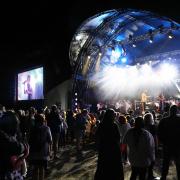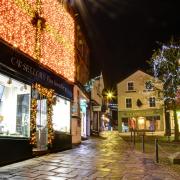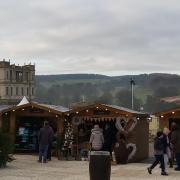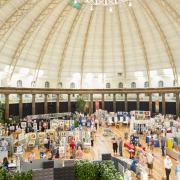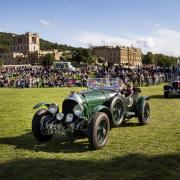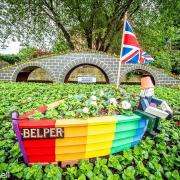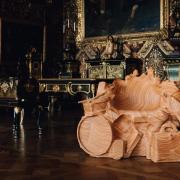On the 200th anniversary of its publication, Nigel Powlson explores Derbyshire’s link to one of the nation’s favourite novels
There is ‘no finer county in England than Derbyshire’ Jane Austen declared in her best-loved novel Pride and Prejudice.
Two centuries and 20 million copies later, that love affair between the writer and Derbyshire continues with visitors eternally following in Austen’s footsteps to feel closer to the enduring characters in one of the most popular novels in the English language.
TV and film adaptations have added millions more Pride and Prejudice enthusiasts and have created a mini tourist industry in the county as fans seek out the locations used on visits to Derbyshire.
It means a continuation of the timeline that began well before the book was first published when impressions of Derbyshire were fixed in the author’s mind to be stored and used in the creation of her great romantic comedy.
Born in 1775 in the pretty Hampshire village of Steventon, in the heart of the South Downs, Austen never lived in Derbyshire but has done more than most to put the county on the tourist map. Like her wilful heroine Elizabeth Bennet in Pride and Prejudice, the young Jane was a keen walker and that was possibly what sparked her enthusiasm for the Peak District.
She famously visited Derbyshire prior to the publication of Pride and Prejudice, staying at the Rutland Arms in Bakewell in 1811, where she is believed to have revised the final chapters of the novel with fresh material gathered from her trip, including a visit to nearby Chatsworth House.
She wrote in the novel: ‘It is not the object of this work to give a description of Derbyshire... all are sufficiently known. A small part of Derbyshire is all the present concern. To the little town of Lambton, the scene of Mr Gardiner’s former residence, and where she had lately learned that some acquaintance still remained, they bent their steps, after having seen all the principal wonders of the county; and within five miles of Lambton, Elizabeth found from her aunt that Pemberley was situated.’
The novel’s Lambton is a fictionalised version of Bakewell, whilst Pemberley, the imaginary ancestral home of everyone’s favourite dashing hero Darcy, takes its lead from Chatsworth, even though the Palace of the Peaks is mentioned separately in the novel as one of the places Elizabeth visits alongside Matlock and Dove Dale.
You can certainly picture Chatsworth when reading Austen’s description of Pemberley – ‘a large, handsome, stone building, standing well on rising ground, and backed by a ridge of high woody hills.’
So it was no surprise that the ancestral home of the Duke of Devonshire was used for the 2005 film adaptation of Pride and Prejudice starring Kiera Knightley as Elizabeth Bennet and Matthew Macfadyen as Darcy.
Even eight years on, visitors are drawn to the Painted Hall and Sculpture Gallery, which both feature in the production, as well as Chatsworth’s exteriors.
As Pride and Prejudice seems to act as a template for the majority of today’s filmed romantic comedies, it’s surprising that the 2005 film was only the second proper movie version.
The first was a creaky 1940 offering starring Laurence Olivier and Greer Garson, which never set foot in England, let alone Derbyshire, and which was made redundant by the much-loved 1995 BBC TV series starring Colin Firth and Jennifer Ehle.
However, although the television success presented the novel in its entirety, the two-hour film version, directed by Joe Wright, is closer to the true tone of the book, offering a moodier Pride and Prejudice, in which the emotional undercurrent ripples close to the surface, as well as a more gritty and passionate look at life at the end of the 18th century.
With some exteriors also shot on location in Derbyshire, Wright’s film makes wonderful use of landscape throughout, never missing a trick to capture a mood.
Darcy’s dramatic proposal to Elizabeth, for example, doesn’t take place in a stuffy drawing room but in the pouring rain against a threatening sky and the iconic image from the film is of Keira Knightley, in reflective mood, on Stanage Edge.
If you want to complete the tourist trail for the movie you may wish to stay at the Peacock Hotel in Rowsley, a former manor house dating back to the 17th century where the cast and crew working on the film were based during their stay in Derbyshire.
Also on your checklist will be Haddon Hall, the home of the Manners Family for more than 800 years. Its banqueting hall, considered to be one of the finest medieval rooms in the country, became the Inn at Lambton in the film and, the crew making good use of the location, the dining room became Elizabeth Bennet’s bedroom.
The 1995 BBC production took in different locations but still needed the Peak District to bring out the full character of the novel.
This time Lyme Park was used when the BBC wanted to film the grounds of Pemberley and was the setting for the most famous moment in the adaptation, when Colin Firth set a million hearts aflutter by emerging drenched from the lake after an impromptu swim. It has been reported that the 12-foot sculpture of the romantic hero that recently appeared in the Serpentine lake in Hyde Park, will tour the UK before settling at Lyme Park!
The interiors of Darcy’s home were filmed in the south of Derbyshire at Sudbury Hall, built by George Vernon in the second half of the 17th century and now maintained by The National Trust. The house’s Long Gallery and the Main Hall and staircase featured prominently and can be visited during normal opening hours for the house.
It all worked a treat and, even though the series has been re-run many times, it has still become one of the BBC’s best-selling home entertainment releases of all-time.
Originally released on VHS in 1995, 70,000 copies were sold by the end of the first week. That rose quickly to 200,000 copies, unheard of for a TV series that 10 million people had already seen and that had only just finished airing. It has since sold equally well on DVD and Blu-ray.
All this from a story that was at first turned down by publishers who didn’t see its potential. Originally crafted as early as 1795, and entitled First Impressions, it was put forward for publication by Austen’s father to London bookseller Thomas Cadell, but he immediately declined.
It was nearly 17 years later that Austen returned to it, refreshing the work and renaming the story Pride and Prejudice in the process.
Sadly, Austen, who was never rich and suffered the same genteel threat of poverty experienced by the Bennets in Pride and Prejudice, sold the copyright for just £110, £40 less than she received for Sense and Sensibility. The publisher quickly made around £450 from the first two editions of the book alone and by the time the third came out, in 1817, its reputation was established.
It has gone on to capture the imagination of each new generation of readers and is still as fresh and enjoyable to read as ever 200 years on. So much so that in 2003, when the BBC conducted a massive poll to find the nation’s favourite book, only Lord of the Rings finished above Pride and Prejudice.
Join in the celebrations
Pride and Prejudice 200th anniversary at Chatsworth
From July 27-August 29 Chatsworth will be hosting a Georgian Summer - celebrating the bicentenary of the publication of Pride and Prejudice with an exhibition in the New Gallery looking at Chatsworth in the time of Pride and Prejudice and comparing it to Pemberley, and featuring a display of Georgian era items as well as the bust of Mr Darcy from the 2005 film, and Georgian themed events in the garden every Saturday. First is ‘Sing live’ (www.singliveuk.com) on 27th July with between 50-100 singers performing in the garden dressed in Pride and Prejudice costumes. On 1st August you can picnic in the grounds and enjoy an outdoor staging of Pride and Prejudice (gates open at 6.30pm, performance begins at 7.30pm. Adults £15, children £12). There will also be Georgian-themed garden tours looking at the work of garden designer Capability Brown and architect James Paine who designed the Stables at Chatsworth and 2-4-1 entry to house and garden for visitors in Georgian period dress (Saturdays only). Go to www.chatsworth.org/whats-on/events/a-georgian-summer for details.
Pride and Prejudice anniversary at Sudbury Hall
The Search for Mr Darcy – September 18th (starts at 4pm). Tickets £14.50. Booking is essential on 01283 585337. Imagine life at the time of Jane Austen with a high tea, followed by a tour of the interior locations used in the BBC adaptation of Pride and Prejudice.
There will also be a larger celebration of all things Regency with a dance week from 18th to 22nd September, when period dancers will also be performing in the hall.
Go to www.nationaltrust.org.uk






